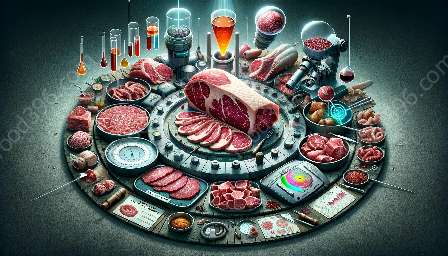Meat microbial quality and safety are critical aspects of the meat industry, impacting both public health and the economic value of meat products. In the evaluation of meat quality, a significant focus is placed on understanding, assessing, and managing microbial hazards to ensure the safety and quality of meat products throughout the supply chain.
Microbial Contamination in Meat
Microorganisms such as bacteria, fungi, and viruses can compromise the safety and shelf life of meat products. Various factors, including animal health, slaughter and processing practices, and storage conditions, can contribute to microbial contamination. The presence of pathogens such as Salmonella, Escherichia coli, Listeria monocytogenes, and Campylobacter is of particular concern due to their potential to cause foodborne illness.
Meat Safety Evaluation
Meat safety evaluation involves the analysis of microbial populations present in meat samples to determine the level of contamination and the potential risk to consumers. Traditional methods such as plate counting and biochemical tests are used to quantify and identify microorganisms. Additionally, molecular techniques like PCR and next-generation sequencing have enabled rapid and accurate detection of specific pathogens, providing valuable insights into microbial safety.
Challenges in Microbial Analysis
Despite advancements in detection methods, microbial analysis of meat poses several challenges. The complex microbiota of meat, variations in microbial load within different cuts, and the presence of background flora can complicate accurate assessment. Furthermore, the emergence of antibiotic-resistant strains and new pathogens necessitates ongoing vigilance and adaptation of analytical techniques.
Regulatory Standards and Control Measures
Regulatory bodies and industry stakeholders have established stringent standards and control measures to minimize microbial hazards in meat. Hazard Analysis and Critical Control Points (HACCP) systems are widely employed to identify and mitigate potential microbial risks at critical stages of meat production, processing, and distribution. Furthermore, the implementation of good manufacturing practices and sanitation protocols is crucial in ensuring microbial safety.
Advancements in Meat Microbial Analysis
Recent advancements in meat microbial analysis have revolutionized the field of meat science. Rapid methods such as biosensors and gene-based detection technologies offer real-time monitoring of microbial contamination, enabling proactive interventions to safeguard meat quality and safety. Additionally, the integration of data analytics and machine learning is enhancing predictive microbiology, allowing for the modeling and management of microbial risks throughout the meat supply chain.
Future Considerations
The future of meat microbial analysis holds promising prospects for the development of novel interventions and technologies. Innovations such as bacteriophage-based biocontrol and advanced packaging solutions tailored to inhibit microbial growth are paving the way for enhanced microbial safety and extended shelf life of meat products. Furthermore, interdisciplinary collaborations between microbiologists, food scientists, and engineers are driving holistic approaches to address microbial challenges in the meat industry.
Understanding the complex dynamics of meat microbial quality and safety is essential for ensuring consumer confidence in meat products and sustaining the viability of the meat industry. By incorporating the latest advancements and comprehensive analysis, the industry can continue to uphold the highest standards of meat safety and quality.

